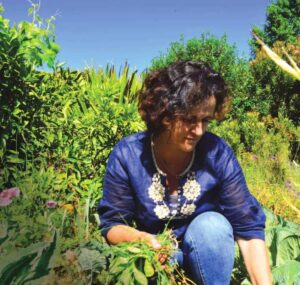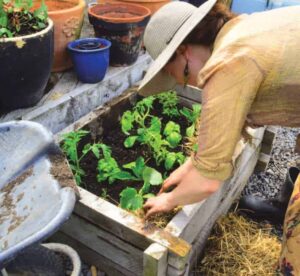Here’s a quick-guide launch to get you growing over the summer. Worried you’ve missed the boat? In sunny Hawke’s Bay, where we’re blessed with the country’s best food-growing climate, it’s never too late to begin. The Farmers’ Market, for example, offers a lush variety of instant start-up seedlings all year round.
As for time, Janet estimates that to maintain a reasonable family veggie garden over summer, you’ll need, on average, three hours a week: “Twenty minutes here, a half hour there for watering, quick weeding, replanting, etc.”
And for a compact, ten-minutes-per-day gardening alternative, try out our summer planter box ‘recipe’
Start-up: site, soil, water
The best site for your garden should have at least six hours of full sun in summer, not be shaded by overhead trees, be near a water source and as close to the house as possible, as you’ll be more inclined to use what you grow if it’s within handy reach.
But use whatever space you have: containers on a balcony, vertical planting up a wall, or dig up a sunny corner of your lawn. Consider using the grassed council verge for growing pumpkins (which sprawl) and corn, for example. Janet’s planted her verge with fruit trees: “I don’t think the council really mind as long as it’s kept tidy.”
Janet’s mantra: “Healthy soil = healthy food”. To create a fertile foundation for your veggies, she says, use a layer system of carbon and nitrogen: collect fallen leaves, animal manure, lawn clippings, kitchen scraps and then “layer these up to create a compost in situ”.
Mulching soil is important, especially in Hawke’s Bay; mulch retains moisture, while also suppressing weeds. Pea straw is best – it’s nutrient-rich and locally grown – but any straw is fine. Also excellent: old pieces of carpet, sheep-dag wool, coffee grounds. Don’t put down wood bark or wood chips, Janet cautions, when they break down they rob the soil of nitrogen; save these for your ornamentals.
You’ll need decent irrigation, whether that be a drip-feed system with a tap timer, or simply a hose and sprinkler. Water early mornings or from late afternoon on; avoid the sun-burn hours as a rule of thumb. Water your plants every third day in summer, advises Janet, giving “a really deep water to their roots”.
“The best time to water is in the evening with the hose in one hand and a glass of wine in the other.” It’s the perfect opportunity to look over your garden and make plans, while enjoying the leisure of daylight savings.

What to grow
“It’s important to grow stuff the family will eat,” says Janet.” It’s no good growing broad beans if no one likes them.” For summer essentials that grow well in Hawke’s Bay, she recommends bush beans, brassicas and leafy greens like kale, tomatoes, mesculun, lettuce, corn, courgettes, and Mediterranean herbs (rosemary, thyme, oregano, basil).
Source local seedlings, as they’re usually best adapted to our growing conditions. Heirloom plants are a good pick as they tend to be more hardy and nutritionally dense.
Plants on offer at the Farmers’ Market will give you a good indication of what you can pop in the ground right away, and stall holders will be able to tell you how to nurture them best to full productivity. Links Organics have beautiful, strong seedlings, while Granny McNabb’s specialise in heritage varieties. Kahikatea Farm in Otane have several seedling stands around the Bay; they also run permaculture and gardening courses (kahikateafarm.co.nz).

“Planting from seed needs a little more skill and time”, but it’s more cost effective. Janet recommends buying a seed-raising mix to get good germination and using a spray bottle to keep soil moist and not water-logged. If you grow from heirloom seed, you can also collect seed for the following year. Setha’s Seeds in CHB is a great local source (sethasseeds.co.nz).
How to grow it
When you start out, it’s tempting to try and feed the whole neighbourhood, but it’s better (and more sustainable) to start small, says Janet, then increase your size as your confidence and capacity grows. Go for small succession plantings rather than plant too much at once and fi nd yourself with 15 lettuces, for instance, that need eating right away.
But, she’s emphatic, “There are no rules!” Veggies can be planted in ornamental beds, for example. “Garlic and roses go really well together … and there’s nothing to say you shouldn’t do it.”
As to neat rows vs eclectic disorder, “If you’re a Virgo, by all means go for straight lines, but planting higgeldy-piggeldy is really quite good.” It allows you to fi ll gaps, trick pests (snails won’t eat all your lettuces if they’re tucked in diff erent spots), companion plant (pairing plants that thrive together) and rotate crops on a micro-scale.
With gardening, there’s no harm done if it goes wrong, says Janet, so don’t be scared of failure and of trying things out.
Summer tips
For herbs that struggle to thrive in the heat, like dill, chives and parsley, sow and grow these on your kitchen window sill. It’s easy then to tend to them daily (a quick splash of water when you’re washing up dishes) and convenient to harvest as you’re prepping dinner.
At Christmas, you could sow French beans, radish, lettuce, beetroot and all your brassicas, Janet suggests. Traditionally cloves of garlic are planted on the summer solstice (to be harvested in winter).
With gardening, it’s all about thinking ahead, so even as you enjoy the scorching Hawke’s Bay summer, you will need to turn your mind towards autumn. January and February is the time for sowing your cool crops like leeks, kale, broad beans, as you continue your successional plantings of quick growing vege (radish, lettuce, bok choi, etc).
You need to think too about how you’re going to preserve your harvest, or if you have a glut, about swapping produce.
Weeds and pests
If you use thick mulch and a no-dig method, you shouldn’t get too many weeds. Pick out larger ones with your fi ngers, Janet advises, and “throw on a concrete path in the hot sun”; they’ll shrivel up quickly and then you can add to your mulch, although tenacious rhizoids like oxalis and convolvulus need to be tossed in a wheelie bin or burnt. You can get a spray, such as ‘Death to Oxalis’, that target these directly if the idea of sifting through soil to root out is too much, but Janet encourages people to try and grow organically.
It makes sense to encourage beneficial insect life, like ladybirds which eat aphids, native wasps for pollination. These are “nature’s tools” and can help make gardening easier in the long run. “Once you start spraying insecticide you kill everything, also the good.” If you do chose to spray, then choose an organic product like neem or pyrethrum, she suggests, and target the problem rather than applying generally.
The number one pest in her view is birds – the only real solution here is netting. As for slugs, snails, white butterflies, while there are all kinds of eco-friendly methods, Janet’s main advice: “Don’t get too precious about the outer leaves being nibbled.”

Resources
Libraries house an array of good gardening books. Janet Luke’s own book Green Urban Living (and her website greenurbanliving. co.nz) has a plethora of simple, practical tips on growing veggies, fruit, and keeping “micro-livestock” like bees and chooks, while NZ Gardener magazine is a popular help-meet. There’s plenty of green-thumb support online, including local gardening groups and produce exchange on social media, and there can be a whole wealth of wisdom to be found in chatting over the back fence with neighbours.
Check out the Environment Centre too in Hastings, environmentcentre.org.nz, which runs workshops throughout the year on home food production, composting, seed sowing, and also showcases a sustainable back yard, replete with veggie gardens, worm farms and a top-bar beehive.
Happy growing and good luck!

Your summer planter box courtesy of Janet Luke
• Plant: One cucumber on one side of the box so that it can trail down
• Thyme and oregano on the other side, which will cascade over.
• One tall staked tomato in the middle with basil interplanted around it.
• A few small bunching lettuce or cos lettuce.
• Sow some radish and carrots together in one spot – the radish is quick growing and you can harvest first, leaving room for the carrots to fill out.
• A couple of bok choi in any spare spaces.
• Mulch with pea straw and water frequently, as container gardens dry out quickly.


Hi There, I’m just about at my wits end trying to find a copy of Janet Luke’s book “Green Urban Living”.
I would pay anything for a even a pre-loved copy if there is one around. I have amanged to borrow one from our local kindy but it needed to go back, I’ve been searching for months now and I’m getting nowhere and also getting desperate.
Can you help at all please?
I look forward to hearing from you.
Kind Regards
Cathy Flynn